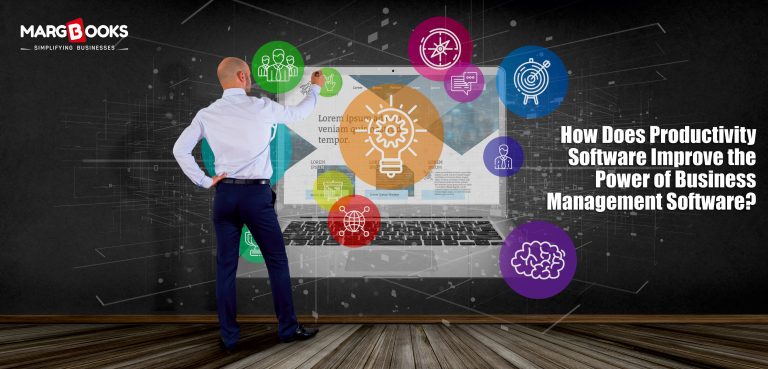In today’s fast-paced digital world, businesses of all sizes are turning to smart tools to stay competitive and agile. While Business Management Software has become the backbone of daily operations for countless companies, pairing it with the right productivity software can take efficiency and performance to the next level.
From small retailers to large enterprises, Indian businesses are now realizing that the integration of productivity tools within their management systems isn’t just a luxury—it’s a necessity.
What is Productivity Software?
At its core, productivity software refers to digital tools that help individuals and teams get more work done in less time. It can include everything from project management applications, task scheduling tools, communication platforms, document editors, to collaboration suites.
Common examples include:
- Microsoft Office (Word, Excel, PowerPoint)
- Google Workspace (Docs, Sheets, Meet)
- Slack and Microsoft Teams
- Trello, Asana, or Notion
However, when these tools are embedded or integrated with a Business Management Software, their potential multiplies.
The Power of Business Management Software
Business Management Software is an umbrella term for applications that help manage the core functions of a business—like accounting, inventory, payroll, billing, customer relationship management (CRM), and more.
A popular example in the Indian market is MargBooks, a cloud-based accounting and inventory platform that’s designed for Indian SMEs and retailers. MargBooks offers everything from GST billing, e-invoicing, inventory tracking to sales and purchase management—all in one place.
But imagine combining this robust software with tools that help you plan your day, coordinate with your team, and stay on top of your tasks. That’s where productivity software steps in.
How Productivity Software Enhances Business Management Tools
Here’s a closer look at how adding productivity software to your business toolkit can unlock new levels of performance:
1. Streamlined Communication
Miscommunication is one of the biggest productivity killers in any organization. With integrated messaging or collaboration tools like Slack or Microsoft Teams, team members can:
- Get real-time updates on sales or stock levels
- Quickly coordinate with procurement or accounts
- Share documents and reports instantly
Imagine your MargBooks dashboard alerting the sales team on Teams when inventory drops below a threshold—saving time and avoiding missteps.
2. Improved Task and Time Management
When team members know what they need to do and by when, work gets done faster. Tools like Trello or Asana allow businesses to:
- Assign responsibilities for daily operations like invoicing, follow-ups, or reconciliations
- Set deadlines for vendor payments or tax filings
- Track progress and accountability
Combining this with MargBooks can ensure financial and operational tasks are completed on schedule without last-minute surprises.
3. Better Collaboration Across Departments
Productivity software often includes shared workspaces, live editing, and cloud syncing. When teams work from different locations or departments (say, sales in Delhi and accounts in Mumbai), productivity tools bridge the gap.
- Shared Google Sheets can track delivery timelines or payment statuses.
- MargBooks-generated reports can be directly added into shared folders for audit or compliance checks.
- Multiple users can work simultaneously on a single process or document, reducing delays.
4. Data-Driven Decision Making
Most Business Management Software, including MargBooks, generates a wealth of data—sales trends, outstanding payments, stock movement, etc.
Using productivity tools, this data can be turned into actionable insights:
- Build dashboards in Google Data Studio using MargBooks exports.
- Use Excel to create predictive sales models from historical data.
- Set automated alerts for sales milestones or overdue bills.
This means faster, smarter business decisions without sifting through hundreds of reports manually.
5. Increased Employee Satisfaction
Let’s face it—employees are more productive when they’re not bogged down by repetitive tasks or unclear instructions. With well-integrated productivity solutions:
- Time-consuming processes can be automated or simplified
- Employees can focus on high-value work rather than data entry
- Transparent workflows mean fewer misunderstandings and more ownership
Over time, this leads to better morale, less burnout, and improved retention.
MargBooks + Productivity Software = A Winning Combination
When you combine a powerful Indian Business Management Software like MargBooks with the efficiency of modern productivity software, you get a business system that works smarter, not harder.
Here’s a simple example:
Scenario: A wholesaler uses MargBooks for stock and billing. They integrate Trello to manage supplier communications and Google Calendar for reminders on order cycles.
Result: Fewer missed orders, timely billing, improved customer satisfaction, and better inventory turnover.
Whether you’re a retailer, manufacturer, distributor, or service provider, this kind of integration helps you stay one step ahead in an increasingly competitive marketplace.
Final Thoughts
As businesses continue to navigate the complexities of the modern economy, relying on just one kind of software isn’t enough anymore. It’s the blend of tools—Business Management Software for structure and productivity software for execution—that creates a holistic system for growth.
Platforms like MargBooks are already empowering Indian businesses to take control of their finances and operations. By complementing them with productivity tools, companies can boost efficiency, reduce errors, and unlock their full potential.
Ready to supercharge your business processes? Start by choosing the right Business Management Software like MargBooks, and pair it with productivity tools that match your team’s workflow. The future of business is not just digital—it’s collaborative, integrated, and intelligent.




